Search Result
Results for "
half-life
" in MedChemExpress (MCE) Product Catalog:
3
Isotope-Labeled Compounds
| Cat. No. |
Product Name |
Target |
Research Areas |
Chemical Structure |
-
- HY-134636
-
|
|
Endogenous Metabolite
|
Endocrinology
|
|
PAPA NONOate is a NO donor with a NO release half-life of 77 min (22-25°C). PAPA NONOate may represent a potential research for impaired wound healing in diabetes by increasing the rate of collagen synthesis at the wound site .
|
-
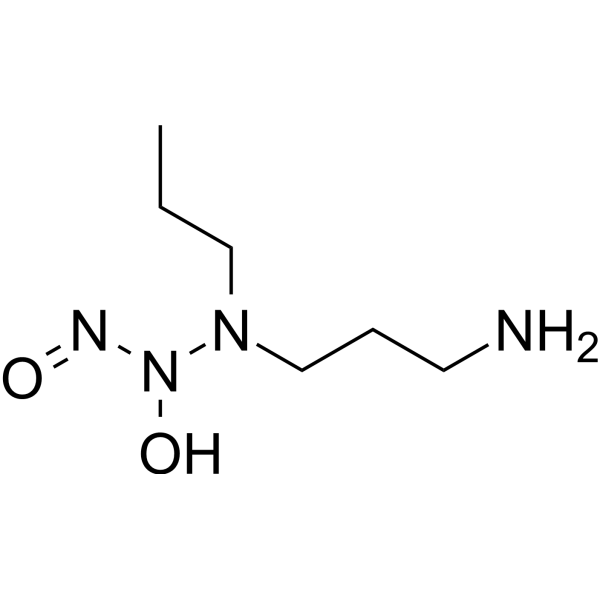
-
- HY-13859
-
|
L-FMAU
|
HBV
DNA/RNA Synthesis
Orthopoxvirus
|
Infection
|
|
Clevudine (L-FMAU), a nucleoside analog of the unnatural L-configuration, has potent anti-HBV activity with long half-life, low toxicity. Clevudine is a non-competitive inhibitor that is not incorporated into the viral DNA but rather binds to the polymerase. Clevudine is active against cowpox virus respiratory infection in mice .
|
-

-
- HY-144771
-
|
|
SARS-CoV
|
Infection
|
|
SARS-CoV-2-IN-14 (compound 6) is a potent inhibitor of SARS-CoV-2 with an IC50 of 0.39 μM. SARS-CoV-2-IN-14 is a niclosamide analogue. SARS-CoV-2-IN-14 contains higher stability in human plasma and liver S9 enzymes assay than niclosamide, which can improve bioavailability and half-life when administered orally .
|
-
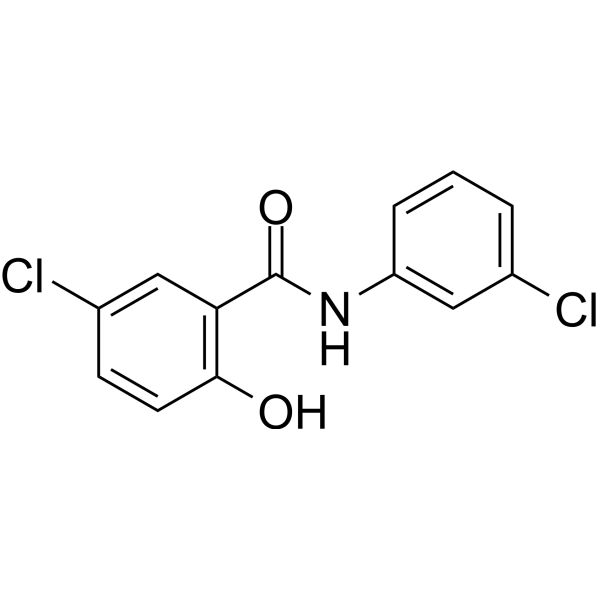
-
- HY-P99478
-
|
|
IFNAR
|
Inflammation/Immunology
|
|
Bifarcept is a recombinant antibody of interferon receptor type I (IFN-RI). Bifarcept can bind IFN-β and prolong its serum half-life .
|
-

-
- HY-144772
-
|
|
SARS-CoV
|
Infection
|
|
SARS-CoV-2-IN-15 (compound 11) is a potent inhibitor of SARS-CoV-2 with an IC50 of 0.49 μM. SARS-CoV-2-IN-15 is a niclosamide analogue. SARS-CoV-2-IN-15 contains higher stability in human plasma and liver S9 enzymes assay than niclosamide, which can improve bioavailability and half-life when administered orally .
|
-
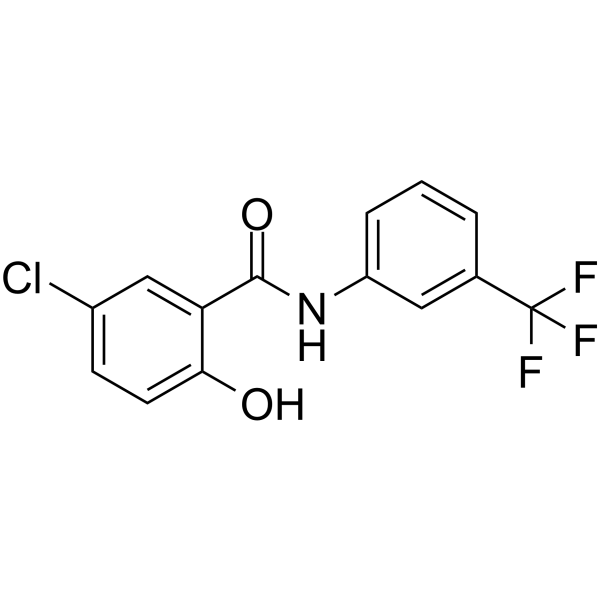
-
- HY-144770
-
|
|
SARS-CoV
|
Infection
|
|
SARS-CoV-2-IN-13 (compound 5) is a potent inhibitor of SARS-CoV-2 with an IC50 of 0.057 μM. SARS-CoV-2-IN-13 is a niclosamide analogue. SARS-CoV-2-IN-13 contains higher stability in human plasma and liver S9 enzymes assay than niclosamide, which can improve bioavailability and half-life when administered orally .
|
-
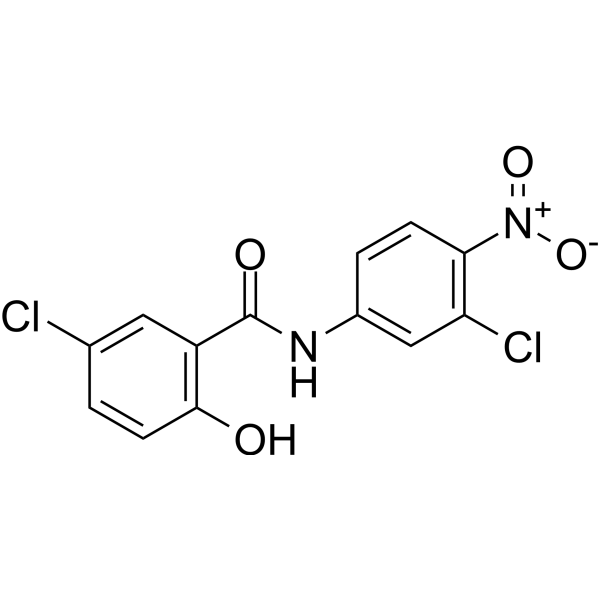
-
- HY-10758
-
|
|
Factor Xa
|
Cardiovascular Disease
|
|
FXa-IN-1 is a FXa inhibitor (IC50: 3 nM, Ki: 0.7 nM) with respectable oral bioavailability and half-life in vivo. FXa-IN-1 can be used for thromboembolic disorders .
|
-

-
- HY-103501
-
|
|
GABA Receptor
|
Neurological Disease
|
|
SB-205384 is a GABAA receptor modulator. The primary effect of SB-205384 on GABAA-activated currents is a prolonged response decay half-life upon removal of the agonist .
|
-
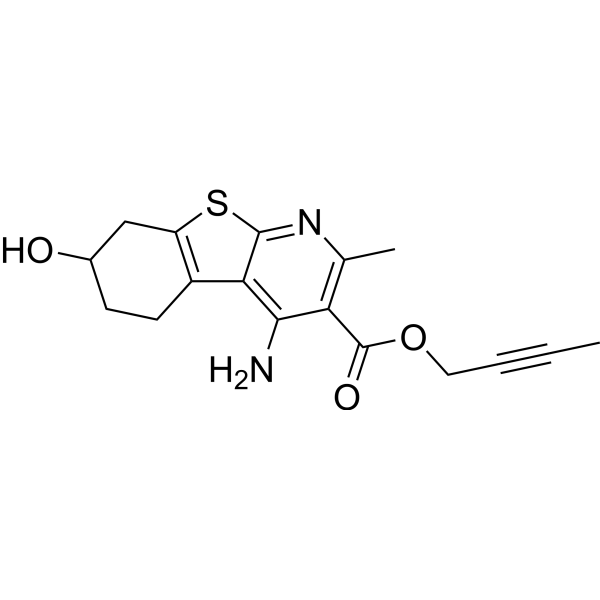
-
- HY-145362
-
|
|
LPL Receptor
|
Others
|
|
S1P1 agonist 4 has a better profile in both potency (EC50 < 0.05 mg/kg) and predicted human half-life (t1/2 ∼ 5 days).
|
-
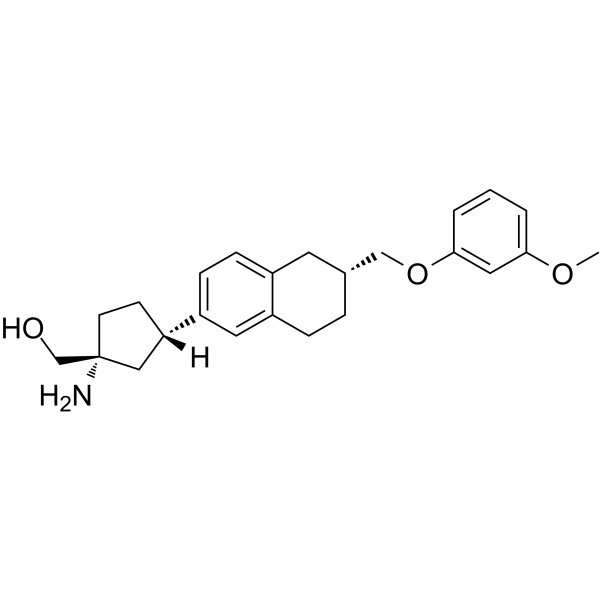
-
- HY-137270
-
|
16,16-Dimethyl prostaglandin A2; Di-M-PGA2
|
Endogenous Metabolite
|
Endocrinology
Cancer
|
|
16,16-Dimethyl PGA2 is an orally active prostaglandin analog with a prolonged in vivo half-life. 16,16-Dimethyl PGA2 can be used to study hypertension .
|
-

-
- HY-135842
-
|
|
Bacterial
Antibiotic
|
Infection
|
|
Aspoxicillin is a broad-spectrum antimicrobial agent against 68 isolates of Actinobacillus pleuropneumoniae with an MIC90 value of <= 0.05 μg/ml. Aspoxicillin has a long half-life in mouse serum of 55 minutes .
|
-

-
- HY-148571
-
-
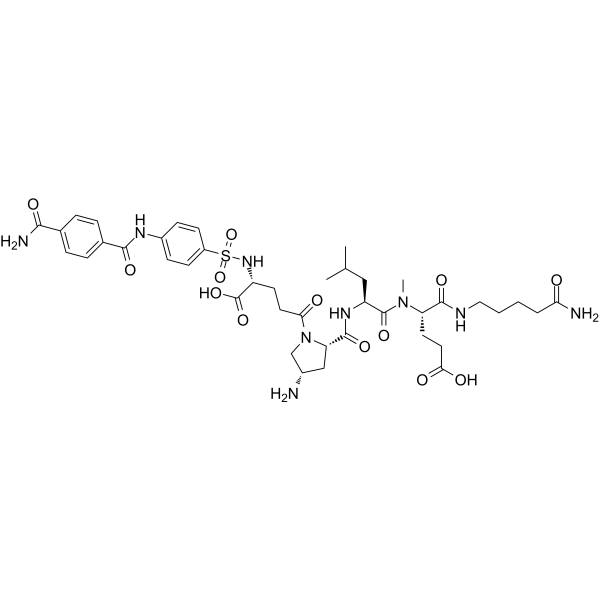
-
- HY-14834
-
-
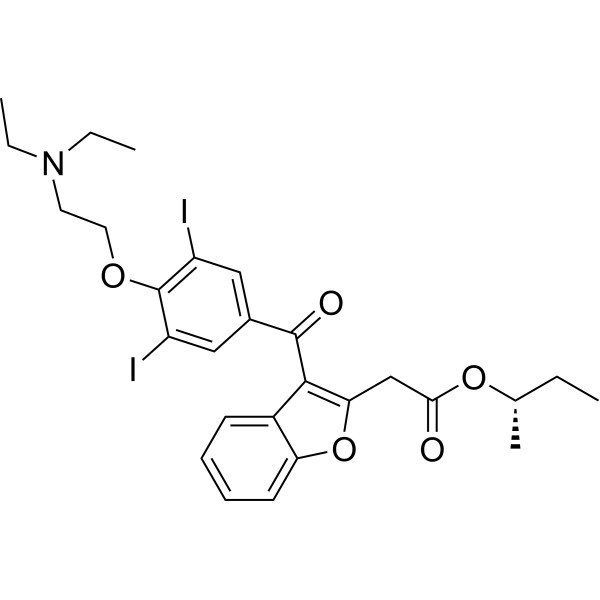
-
- HY-118561
-
|
AD-1590
|
Others
|
Inflammation/Immunology
|
|
Bermoprofen (AD-1590) is an orally active non-steroidal anti-inflammatory agent. Bermoprofen has potent antipyretic activities with a short biological half-life. Bermoprofen is a potent antagonist of LPS-induced fever in rabbits .
|
-
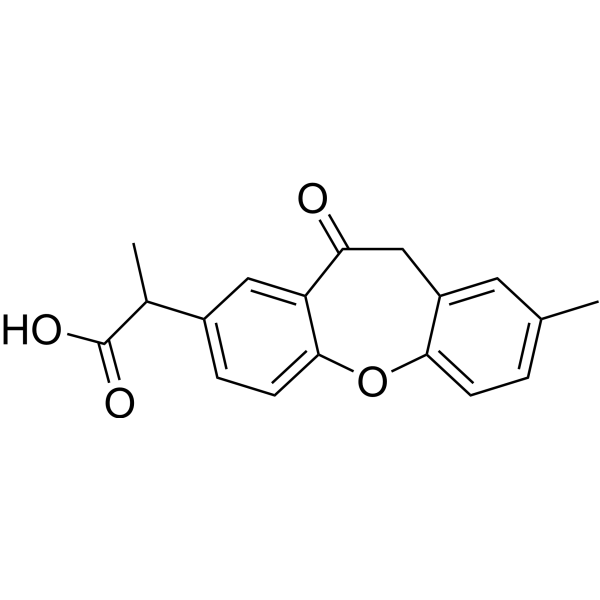
-
- HY-125301
-
|
|
Others
|
Inflammation/Immunology
|
|
Thymoctonan (THF-γ2) is the immunomodulatory octapeptide, thymic humoral factor γ2. Thymoctonan has the half-life less than 6 min at 37 °C in blood from human, rat and mouse .
|
-
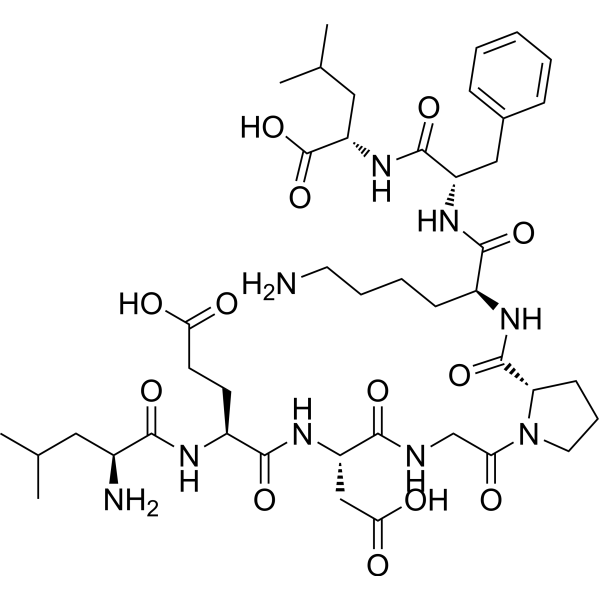
-
- HY-W394903
-
|
|
JAK
Drug Metabolite
|
Cancer
|
|
GS-829845 is a major, active metabolite of Filgotinib (HY-18300). GS-829845 is a JAK1 preferential inhibitor but is approximately 10-fold less potent than the parent and with a longer half-life .
|
-

-
- HY-P99671
-
|
M-6495
|
ADAMTS
|
Inflammation/Immunology
|
|
Isecarosmab (M-6495) is an anti-ADAMTS monoclonal antibody (mAb) with a KD value of 3.65 pM. Isecarosmab has chondroprotective and anti-inflammatory activities. Isecarosmab can bind albumin to extend plasma half-life .
|
-

-
- HY-N4009
-
|
|
Others
|
Others
|
|
Iriflophenone 2-O-α-rhamnoside can be isolated from the leaves of Aquilaria sinensis. Iriflophenone 2-O-α-rhamnoside has a half-life value of 2.44 min in rats at the administration of 25 mg/kg .
|
-
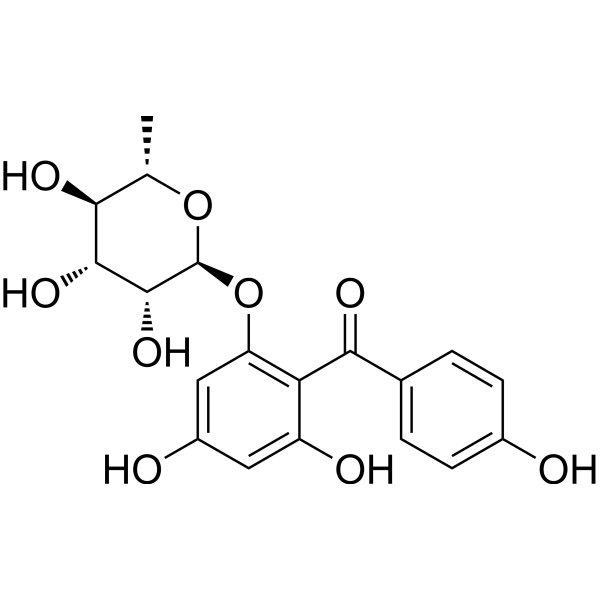
-
- HY-100607A
-
|
ONO1101 hydrochloride
|
Adrenergic Receptor
|
Cardiovascular Disease
Endocrinology
|
|
Landiolol hydrochloride (ONO1101 hydrochloride) is a highly beta1 selective ultra-short acting beta-blocker (β1/β2 selectivity = 255:1, a half-life of 4 min), acts as an adrenoceptor antagonist .
|
-
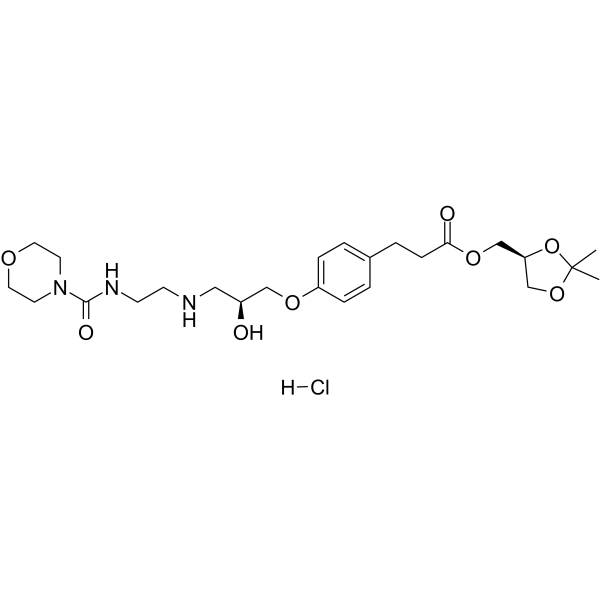
-
- HY-P99350
-
|
AMG 910; Anti-Human CD3xClaudin18 2
|
CD3
|
Cancer
|
|
Gresonitamab (AMG 910) is a half-life extended (HLE) bispecific T-cell engager (BiTE) antibody targets CD3-positive T cells and CLDN18.2-expressing tumor cells. Gresonitamab can be used for the research of adenocarcinoma .
|
-

-
- HY-N7122
-
|
|
|
|
|
Thymopentin is a biologically active peptide secreted mainly by the epithelial cells of thymic cortex and medulla. Thymopentin is an effective immunomodulatory agent with a short plasma half-life of 30 seconds. Thymopentin enhances the generation of T-cell lineage derived from human embryonic stem cells (hESCs) .
|
-
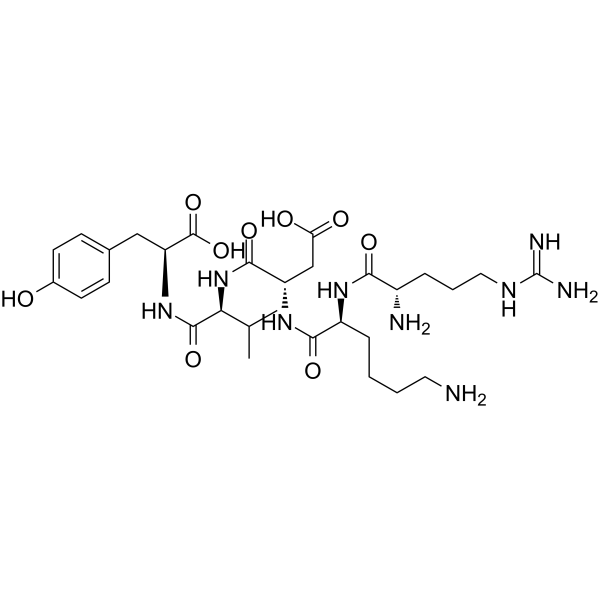
-
- HY-N7122A
-
|
|
Endogenous Metabolite
|
Inflammation/Immunology
Cancer
|
|
Thymopentin acetate is a biologically active peptide secreted mainly by the epithelial cells of thymic cortex and medulla. Thymopentin acetate is an effective immunomodulatory agent with a short plasma half-life of 30 seconds. Thymopentin acetate enhances the generation of T-cell lineage derived from human embryonic stem cells (hESCs) .
|
-
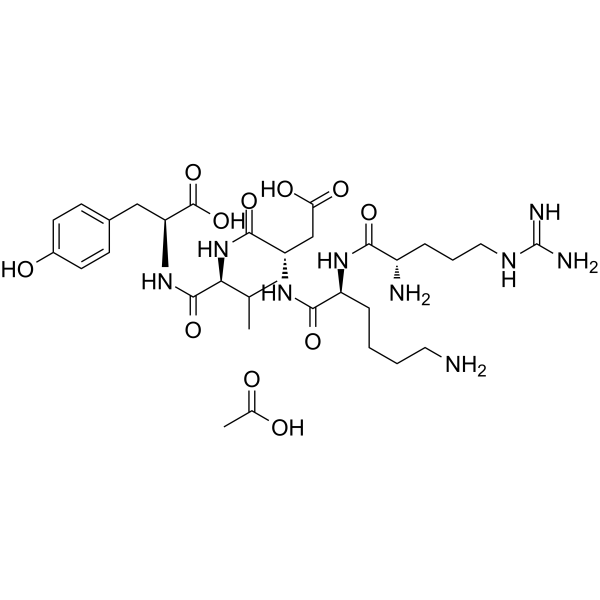
-
- HY-124713
-
|
|
DNA/RNA Synthesis
|
Neurological Disease
|
|
ML372 inhibits survival motor neuron (SMN) protein ubiquitination, increases SMN protein stability without affecting mRNA expression. ML372 improves spinal muscular atrophy (SMA) in mice. ML372 is brain penetrant and has a reasonable exposure and half-life in vivo .
|
-
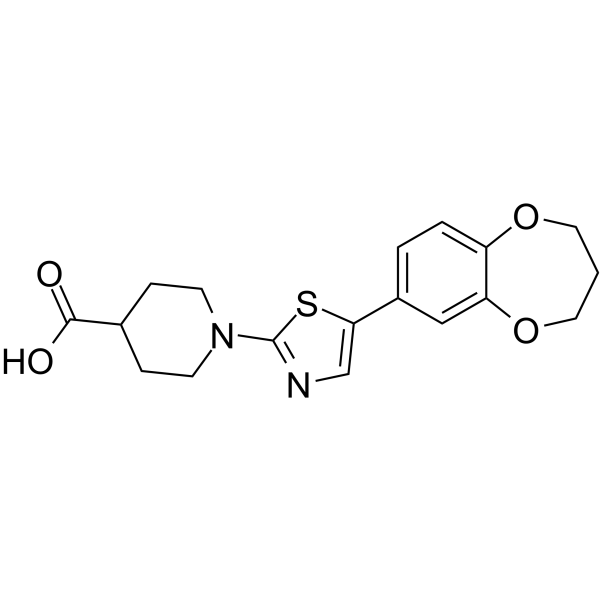
-
- HY-P99756
-
|
MEDI8897
|
RSV
|
Infection
|
|
Nirsevimab (MEDI8897) is a recombinant human respiratory syncytial virus (RSV) monoclonal antibody with modified Fc region, which can prolong its half-life. Nirsevimab has an affinity for RSV-B with an Kd value of 1.5 nM. Nirsevimab can be used for RSV research .
|
-

-
- HY-156188
-
|
|
Others
|
Others
|
|
AChE-IN-41 (Compound 2) is a compound of the Galantamine Memantine hybrid. AChE-IN-41 has the inhibition ability of cholinesterase. AChE-IN-41 shows higher plasma stability and comparable microsomal stability in vitro, while showing lower half-life and faster clearance in vivo .
|
-

-
- HY-P99930
-
|
|
FGFR
|
Metabolic Disease
|
|
Efruxifermin is an Fc-FGF21 fusion protein (human IgG1 Fc domain linked to a modified human FGF21). Efruxifermin has prolonged half-life and enhanced receptor affinity compared with native human FGF21. Efruxifermin can be used for the research of non-alcoholic steatohepatitis .
|
-

-
- HY-P10019
-
|
NLY01
|
GCGR
|
Neurological Disease
|
|
Pegsebrenatide (NLY01) is a long-acting GLP-1R agonist. Pegsebrenatide has an extended half-life and favorable blood-brain barrier penetration. Pegsebrenatide can block A1 astrocyte transformation, reducing dopaminergic cell death, and improving motor symptoms in mouse models of PD .
|
-

-
- HY-14466
-
|
|
Prostaglandin Receptor
|
Endocrinology
|
|
GW 848687X is a selective, orally active prostaglandin EP1 receptor antagonist for the inhibition of inflammatory pain. The oral bioavailability of GW 848687X was 54% in rats and 53% in dogs. GW 848687X has a half-life of 2 hours and has inhibitory potential for both acute and chronic pain .
|
-
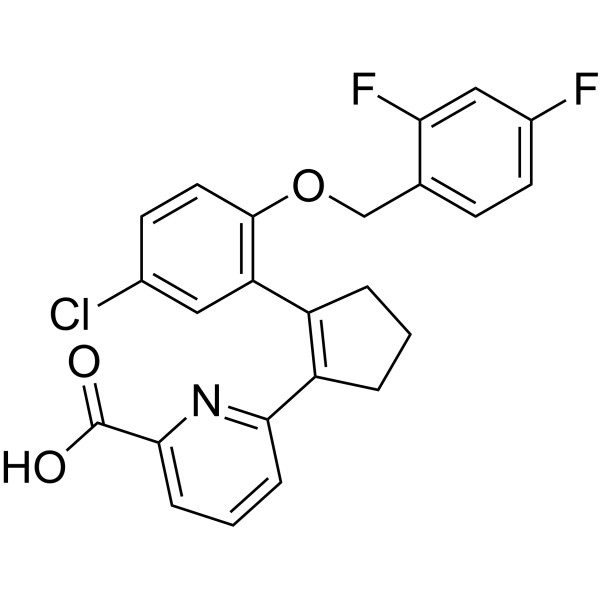
-
- HY-B1118S
-
|
RP-14539-d6; PM-185184-d6
|
Parasite
Antibiotic
|
Infection
|
|
Secnidazole-d6 is the deuterium labeled Secnidazole. Secnidazole (RP-14539;PM-185184) is an orally active azole antibiotic with a longer half-life than metronidazole (HY-B0318). Secnidazole is against the vaginosis-associated bacteria and has the potential for bacterial vaginosis research[1].
|
-
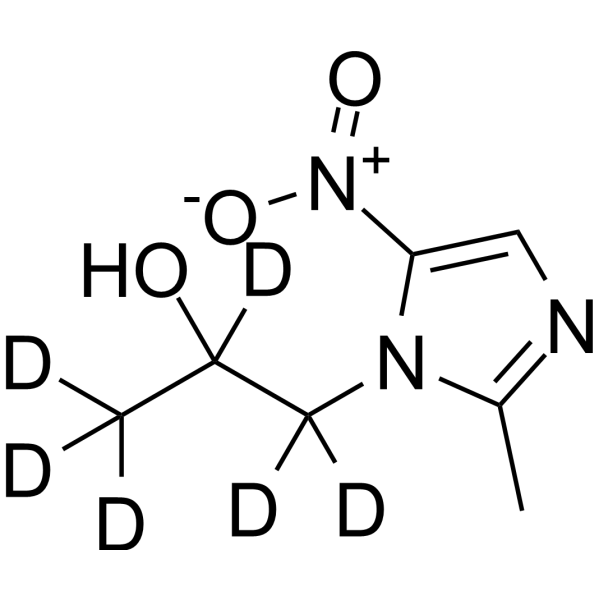
-
- HY-100658
-
|
|
5-HT Receptor
Dopamine Receptor
|
Neurological Disease
|
|
Didesmethyl cariprazine is a metabolite of Cariprazine and acts as the predominant circulating active moiety. Didesmethyl cariprazine has a long half-life of 1-3 weeks. Cariprazine is a antipsychotic agent candidate that exhibits high affinity for the D3 and D2 receptors, and moderate affinity for the 5-HT1A receptor .
|
-
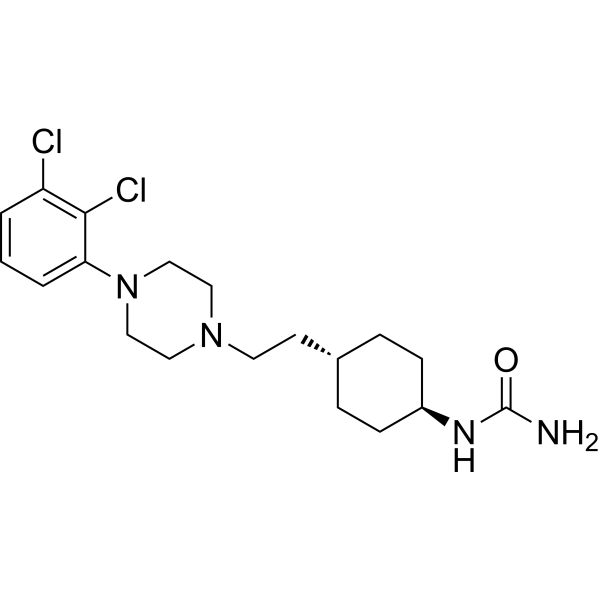
-
- HY-155507
-
|
|
c-Myc
|
Cancer
|
|
c-Myc inhibitor 11 (Compound 67e) is a c-MYC inhibitor (pEC50: 6.4). c-Myc inhibitor 11 has high clearance levels, moderate volume of distribution and short half-life in rat pharmacokinetic assay. c-Myc inhibitor 11 can be used for cancer research .
|
-

-
- HY-162351
-
|
|
Others
|
Metabolic Disease
|
|
EBP-IN-1 (compound 11) is an inhibitor of emopamil-binding protein (EBP), a sterol isomerase in the cholesterol biosynthetic pathway. EBP-IN-1 has a long half-life in rodents and has good metabolic turnover and brain penetration properties. EBP-IN-1 enhances oligodendrocyte formation in human cortical organoids .
|
-
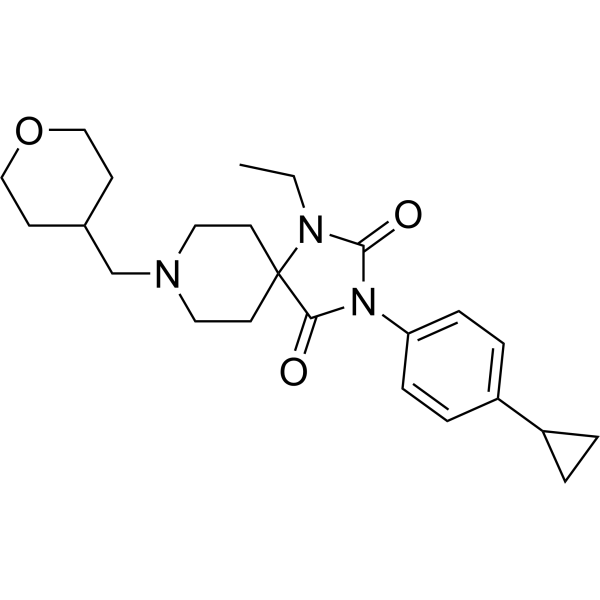
-
- HY-P99562
-
|
XmAb-18087
|
CD3
|
Cancer
|
|
Tidutamab (XmAb-18087) is a humanized and affinity-optimized bispecific antibody (bsAb) targeting SSTR2 binding domain and T-cell binding domain (CD3). Tidutamab possesses a full Fc domain to maintain long serum half-life.Tidutamab eliminates SSTR+ tumor cells by stimulating redirected T cellmediated cytotoxicity (RTcC) .
|
-

-
- HY-121246
-
|
AKF-PD
|
PI3K
Akt
|
Inflammation/Immunology
|
|
Fluorofenidone (AKF-PD), an analogue of AMR69, shows equivalent antifibrotic activity, lower toxicity and longer half-life. Fluorofenidone (AKF-PD) attenuates the progression of renal interstitial fibrosis partly by suppressing NADPH oxidase and extracellular matrix (ECM) deposition via the PI3K/Akt signalling pathway .
|
-
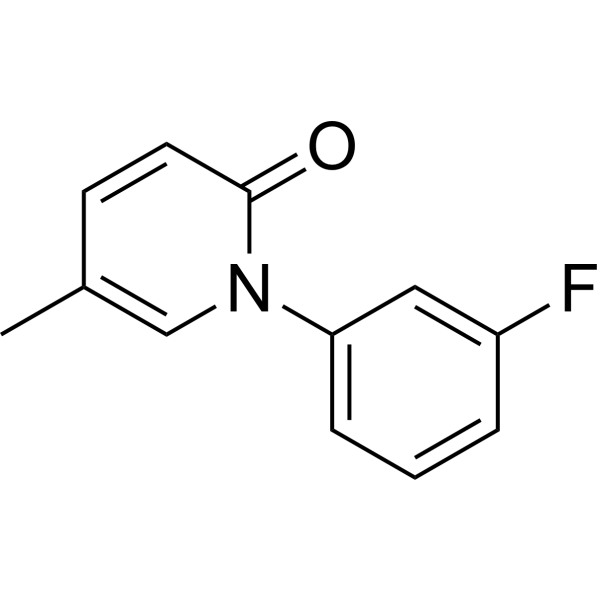
-
- HY-17421
-
|
TU-199
|
Proton Pump
|
Infection
Inflammation/Immunology
|
|
Tenatoprazole (TU-199) is an orally active imidazopyridine-based proton pump inhibitor with a prolonged plasma half-life. Tenatoprazole inhibits hog gastric H +/K +-ATPase activity with an IC50 of 6.2 μM. Tenatoprazole blocks the interaction of ubiquitin with the ESCRT-1 factor Tsg101, inhibits production of several enveloped viruses, including EBV .
|
-
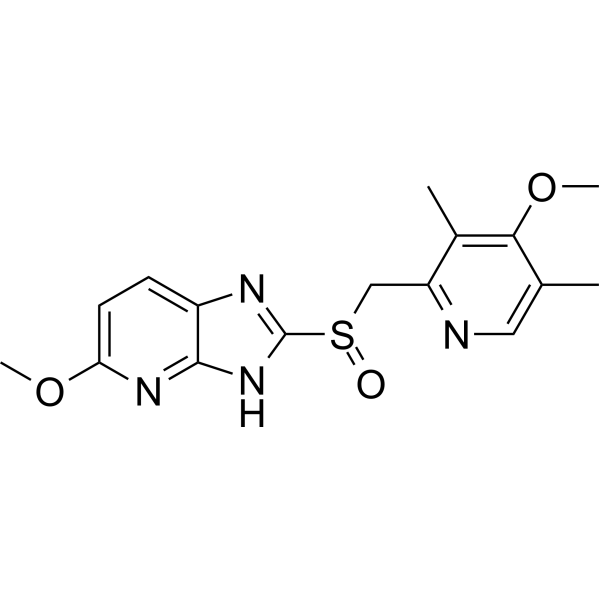
-
- HY-B1118S1
-
|
RP-14539-13C2, 15N2; PM-185184-13C2, 15N2
|
Isotope-Labeled Compounds
Parasite
Antibiotic
|
Infection
|
|
Secnidazole- 13C2, 15N2 is the 13C2, 15N2 labeled Secnidazole. Secnidazole (RP-14539;PM-185184) is an orally active azole antibiotic with a longer half-life than metronidazole (HY-B0318). Secnidazole is against the vaginosis-associated bacteria and has the potential for bacterial vaginosis research.
|
-

-
- HY-149014
-
|
|
Orexin Receptor (OX Receptor)
|
Neurological Disease
|
|
OX2R-IN-1 (compound 15) is a low cytotoxicity profile OX2R-IN-1 antagonist (a potential OX2R binder) with an IC50 value of 484 μM. OX2R-IN-1 (compound 15) can cross the BBB into the brain with a short half-life .
|
-

-
- HY-162121
-
|
|
Others
|
Cancer
|
|
Antitumor agent-129 (Compound 68) is a thiazolidin-4-one sulfone derivative and an Osteosarcoma (OS) inhibitor with an IC50 value of 0.217 μM, a half-life of 73.8 min (mouse liver microsome) and an excellent pharmacokinetic profile (in vivo bioavailability F = 115%, intraperitoneal administration). Antitumor agent-129 is a potential candidate for OS research .
|
-
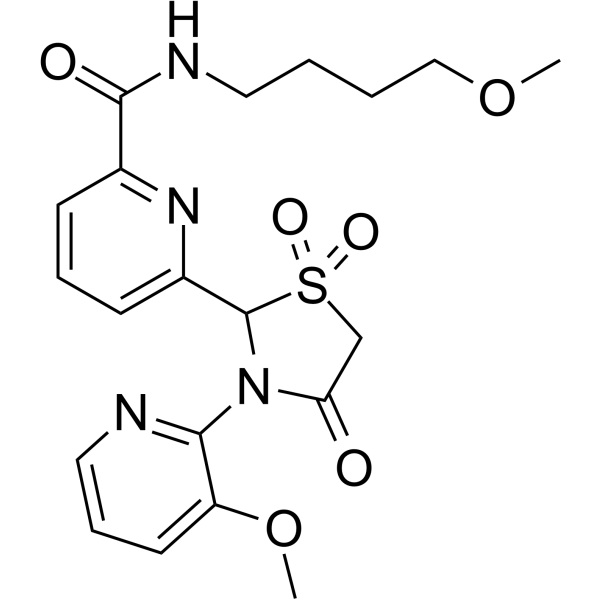
-
- HY-132242
-
|
SFN-NAC
|
HDAC
Apoptosis
|
Cancer
|
|
DL-Sulforaphane N-acetyl-L-cysteine (SFN-NAC) is an orally active HDAC inhibitor and metabolite of sulforaphane (HY-13755) with longer half-life and better blood-brain barrier permeability. DL-Sulforaphane N-acetyl-L-cysteine activates autophagy-mediated downregulation of α-tubulin expression through the ERK pathway and can be used in cancer research .
|
-
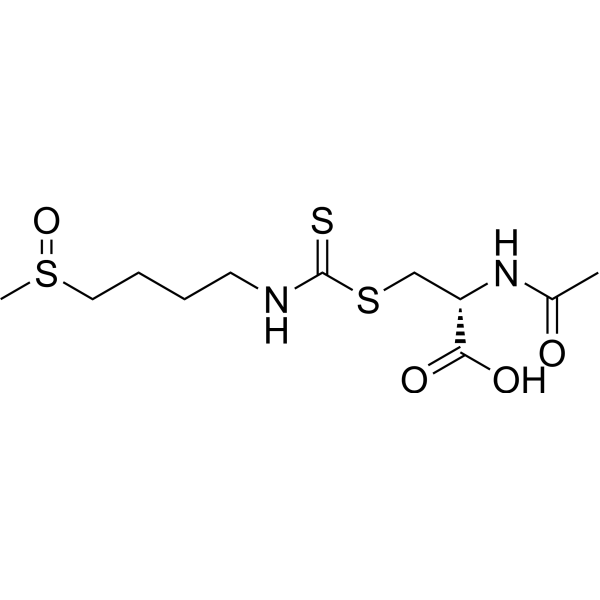
-
- HY-P99814
-
|
AMG-701
|
CD3
|
Inflammation/Immunology
Cancer
|
|
Pavurutamab (AMG-701) is a bispecific T cell engager molecule that anti-CD3 and anti-B cell maturation antigens (BCMA). Pavurutamab has an extended half-life based on Pacanalotamab (HY-P99798). The Fc of Pavurutamab is coupled to molecules to improve pharmacokinetic parameters. Pavurutamab has potential applications in immune regulation and multiple myeloma (MM) .
|
-

-
- HY-135774
-
|
|
Drug Metabolite
Phosphatase
|
Cardiovascular Disease
|
|
6-Hydroxybenzbromarone is the major metabolite of Benzbromarone with a longer half-life and greater pharmacological potency than the parent compound. 6-Hydroxybenzbromarone is a protein Eyes Absent 3 (EYA3) inhibitor with an IC50 value of 21.5 μM. 6-Hydroxybenzbromarone is an anti-angiogenic agent, has strong inhibitory effects on cell migration, tubulogenesis, and angiogenic sprouting .
|
-
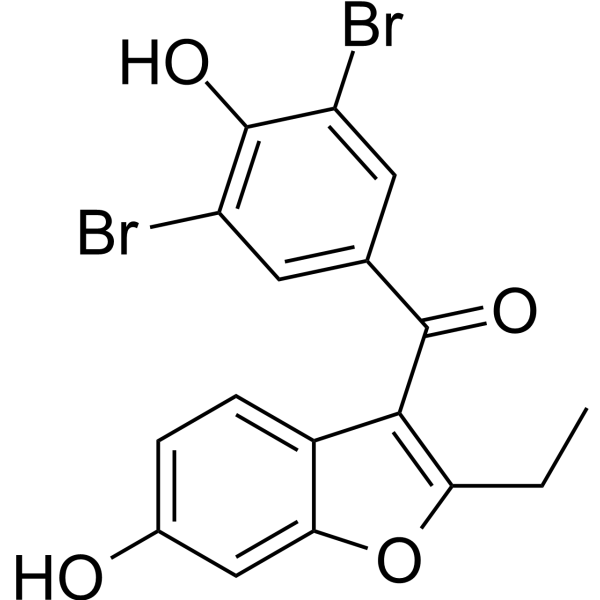
-
- HY-121246S
-
|
AKF-PD-d3
|
Isotope-Labeled Compounds
Akt
PI3K
|
Inflammation/Immunology
|
|
Fluorofenidone-d3 is deuterium labeled Fluorofenidone. Fluorofenidone (AKF-PD), an analogue of AMR69, shows equivalent antifibrotic activity, lower toxicity and longer half-life. Fluorofenidone (AKF-PD) attenuates the progression of renal interstitial fibrosis partly by suppressing NADPH oxidase and extracellular matrix (ECM) deposition via the PI3K/Akt signalling pathway[1][2].
|
-

-
- HY-147336
-
|
|
Drug Metabolite
|
Infection
Cardiovascular Disease
Metabolic Disease
Inflammation/Immunology
|
|
Desmethylazelastine is a main active metabolite of Azelastine that is oxidatively metabolized by the cytochrome P450 enzyme system with a protein binding rate of 97% and an elimination half-life of 54 hours. Azelastine is an orally active, selective and high-affinity histamine H1-receptor antagonist. Azelastine can be used in studies of allergic rhinitis, asthma, diabetic hyperlipidemic and SARS-CoV-2 .
|
-

-
- HY-P99340
-
|
VIR 7831
|
SARS-CoV
|
Infection
|
|
Sotrovimab (VIR 7831) is a human IgG1κ pan-sarbecovirus monoclonal antibody (mAb), neutralizes SARS-CoV-2, SARS-CoV-1, and multiple other sarbecoviruses. Sotrovimab is developed based on S309, exhibits a long half-life and great bioavailability in the respiratory mucosa. Sotrovimab could result in immune-mediated viral clearance and prevent progression of Covid-19 early in the course of disease .
|
-

-
- HY-152142
-
|
|
JNK
|
Neurological Disease
|
|
DN-1289 is an orally active and selective inhibitor of dual leucine zipper kinase (DLK; IC50=17 nM) and leucine zipper-bearing kinase (LZK; IC50=40 nM). DN-1289 results significant attenuation of optic nerve crush (ONC)-induced p-c-Jun in mice model. DN-1289 has excellent in vivo plasma half-life and blood-brain barrier permeability .
|
-
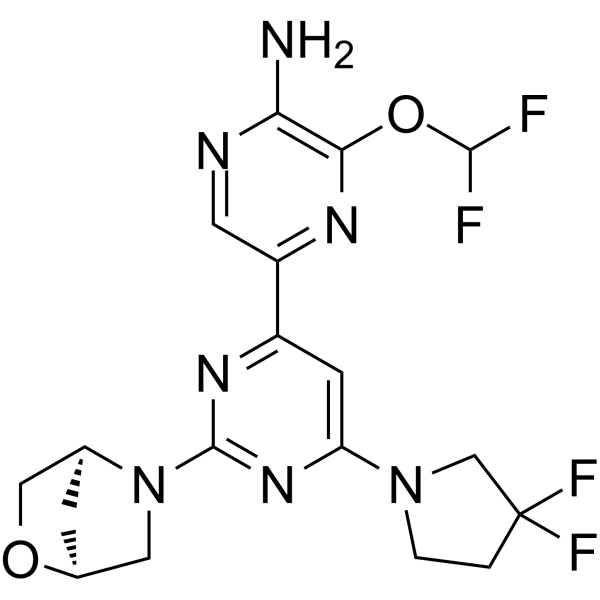
-
- HY-155974
-
|
|
MDM-2/p53
|
Cancer
|
|
MeOIstPyrd is an anti-skin cancer agent. MeOIstPyrd inhibits cell proliferation, migration, and spheroid formation by activating the mitochondrial intrinsic apoptotic pathway. MeOIstPyrd induces DNA damage. MeOIstPyrd activates p53, and increases the half-life of p53 and stabilizes p53 by phosphorylating it at ser15. MeOIstPyrd binds to MDM2 in the p53 sub-pocket and blocks p53-MDM2 interaction .
|
-

-
- HY-117482
-
|
|
γ-secretase
|
Neurological Disease
|
|
BPN-15606 is a highly potent, orally active γ-secretase modulator (GSM), attenuates the production of Aβ42 and Aβ40 by SHSY5Y neuroblastoma cells with IC50 values of 7 nM and 17nM, respectively. BPN-15606 lowers Aβ42 and Aβ40 levels in the central nervous system of rats and mice. BPN-15606 has acceptable PK/PD properties, including bioavailability, half-life, and clearance .
|
-
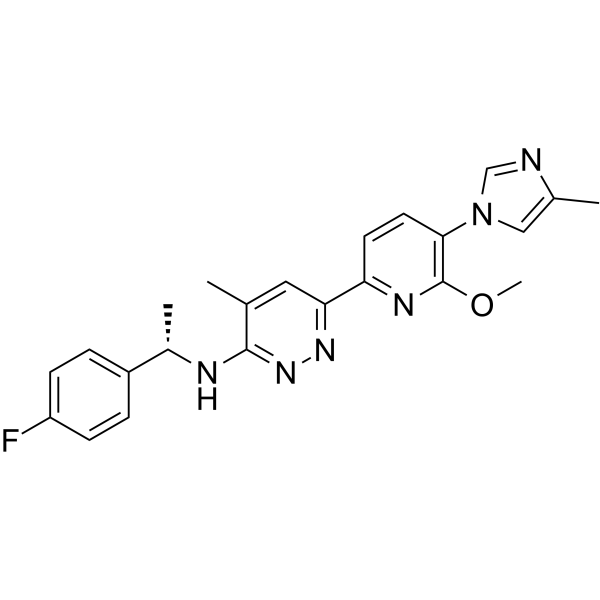
-
- HY-117482A
-
|
|
γ-secretase
|
Neurological Disease
|
|
BPN-15606 besylate is a highly potent, orally active γ-secretase modulator (GSM), attenuates the production of Aβ42 and Aβ40 by SHSY5Y neuroblastoma cells with IC50 values of 7 nM and 17nM, respectively. BPN-15606 besylate lowers Aβ42 and Aβ40 levels in the central nervous system of rats and mice. BPN-15606 besylate has acceptable PK/PD properties, including bioavailability, half-life, and clearance .
|
-
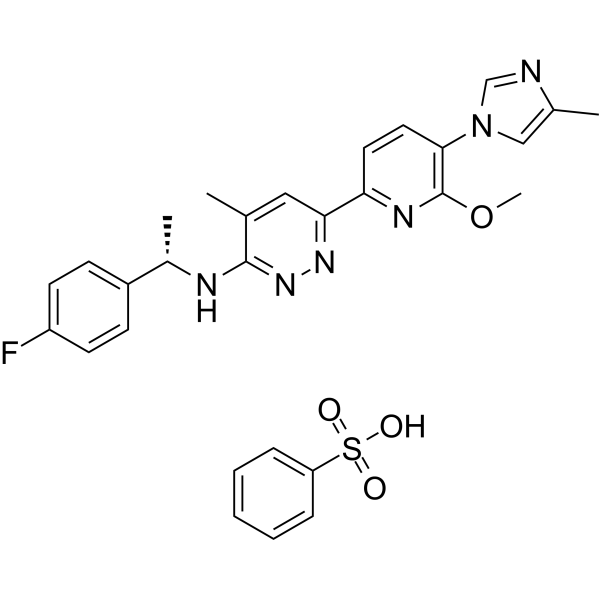
-
- HY-P3347
-
|
|
Apelin Receptor (APJ)
|
Cardiovascular Disease
|
|
NH2-c[X-R-L-S-X]-K-G-P-(D-2Nal) (compound 40), a macrocyclic analogue of Ape13, is a potent APJ agonist (Ki=5.7 nM). NH2-c[X-R-L-S-X]-K-G-P-(D-2Nal) exhibits a favorable Gα12-biased signaling and an increased in vivo half-life .
|
-
![NH2-c[X-R-L-S-X]-K-G-P-(D-2Nal)](//file.medchemexpress.com/product_pic/hy-p3347.gif)
-
- HY-12594
-
|
ABT-450; Veruprevir
|
HCV Protease
HCV
SARS-CoV
|
Infection
|
|
Paritaprevir (ABT-450) is a potent, orally active and antiviral non-structural protein 3/4A (NS3/4A) protease inhibitor with EC50s of 1 and 0.21 nM against HCV 1a and 1b, respectively. Paritaprevir is also a SARS-CoV 3CL pro inhibitor with an IC50 of 1.31 μM. Paritaprevir is metabolized primarily by cytochrome P450 (CYP) 3A. The plasma concentration and half-life of Paritaprevir can be enhanced by Ritonavir (a CYP450 inhibitor) .
|
-
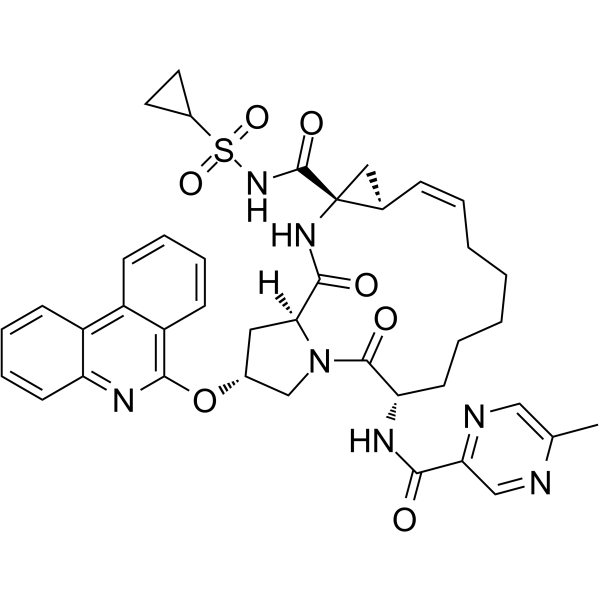
- HY-12594A
-
|
ABT-450 dihydrate; Veruprevir dihydrate
|
HCV Protease
HCV
SARS-CoV
|
Infection
|
|
Paritaprevir (ABT-450) dihydrate is a potent, orally active and antiviral non-structural protein 3/4A (NS3/4A) protease inhibitor with EC50s of 1 and 0.21 nM against HCV 1a and 1b, respectively. Paritaprevir dihydrate is also a SARS-CoV 3CL pro inhibitor with an IC50 of 1.31 μM. Paritaprevir dihydrate is metabolized primarily by cytochrome P450 (CYP) 3A. The plasma concentration and half-life of Paritaprevir dihydrate can be enhanced by Ritonavir (a CYP450 inhibitor) .
|
-
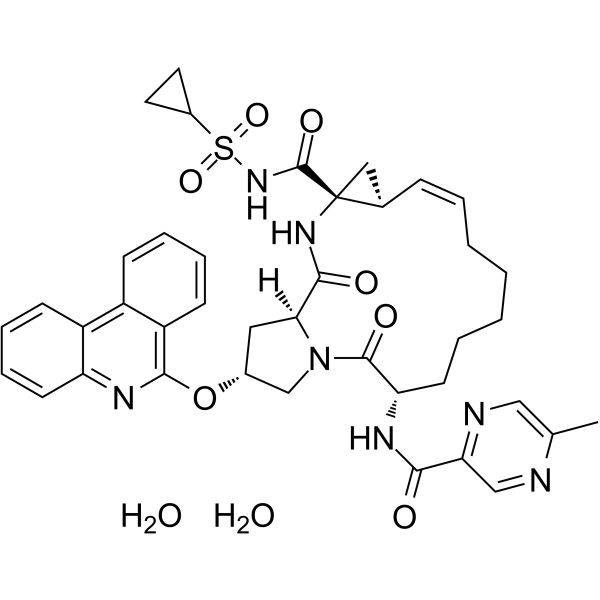
- HY-123022
-
|
CS-023; RO4908463; R-115685
|
Bacterial
|
Infection
|
|
Tomopenem (CS-023; RO4908463; R-115685) is a longer-half-life parenteral carbapenem. Tomopenem shows broad activity against 63 reference species. The activity of tomopenem against 293 clinical isolates is potent (MIC90, 0.06 to 4 μg/mL). Antianaerobic activity .
|
-
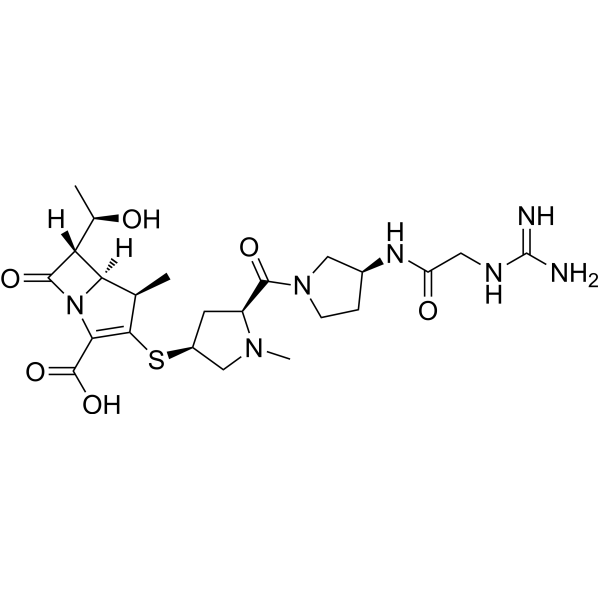
- HY-158122
-
|
|
DNA-PK
|
Cancer
|
|
Lys(CO-C3-p-I-Ph)-O-tBu is a pharmacokinetic modifier (PK modifier) that can improve the PK properties of PSMA ligand molecules. Lys(CO-C3-p-I-Ph)-O-tBu can increase the residence time of PSMA ligand in plasma by increasing its binding capacity to albumin. Lys(CO-C3-p-I-Ph)-O-tBu also reduces salivary gland absorption, possibly extending the half-life of the active compound. Ac-PSMA-trillium is a suitable PSMA-targeting compound that has different biological applications after modification with different radioactive isotopes. If labeled with 111In, it can be used as DOTA chelating agent and imaging agent. Or labeled with 225Ac as a Macropa chelator for targeted radionuclide therapy (TRT) in the study of metastatic castration-resistant prostate cancer (mCRPC) .
|
-
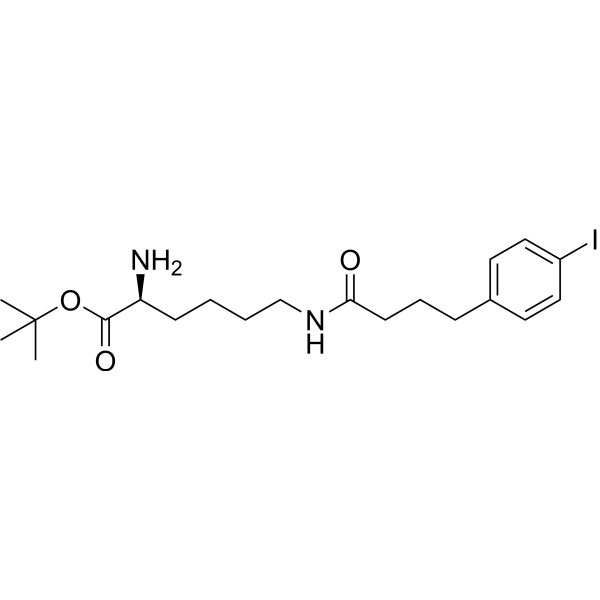
- HY-158118
-
|
|
DNA-PK
|
Cancer
|
|
Lys(CO-C3-p-I-Ph)-OMe is a pharmacokinetic modifier (PK modifier) that can improve the PK properties of PSMA ligand molecules (such as Ac-PSMA-trillium). Lys(CO-C3-p-I-Ph)-OMe can increase the residence time of Ac-PSMA-trillium in plasma by increasing its binding capacity to albumin. Lys(CO-C3-p-I-Ph)-OMe also reduces salivary gland absorption of Ac-PSMA-trillium, potentially extending its half-life. Ac-PSMA-trillium is a suitable PSMA-targeting compound that has different biological applications after modification with different radioactive isotopes. If labeled with 111In, it can be used as DOTA chelating agent and imaging agent. Or labeled with 225Ac as a Macropa chelator for targeted radionuclide therapy (TRT) in the study of metastatic castration-resistant prostate cancer (mCRPC) .
|
-
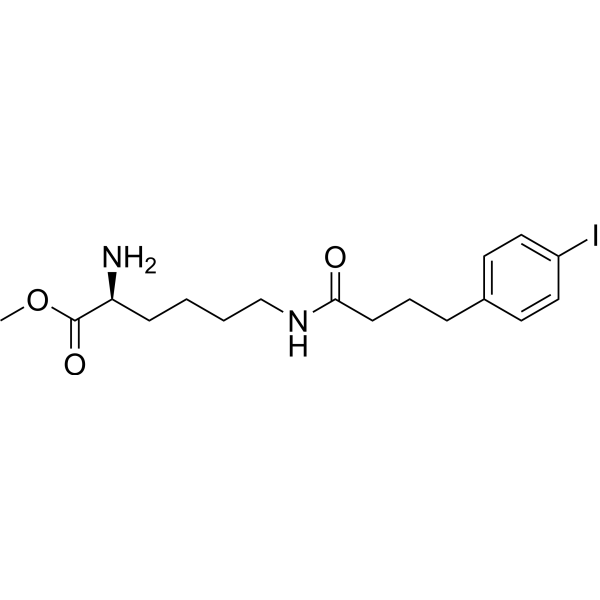
- HY-157929
-
|
|
Keap1-Nrf2
|
Inflammation/Immunology
Cancer
|
|
Keap1-Nrf2-IN-19 (compound 33) is an oral active Keap1-Nrf2 protein–protein interaction (PPI) inhibitor with the Kd value of 0.0014 μM. Keap1-Nrf2-IN-19 exhibits less than 50% inhibition at 30 μM against hERG and 10 μM against CYPs .
|
-
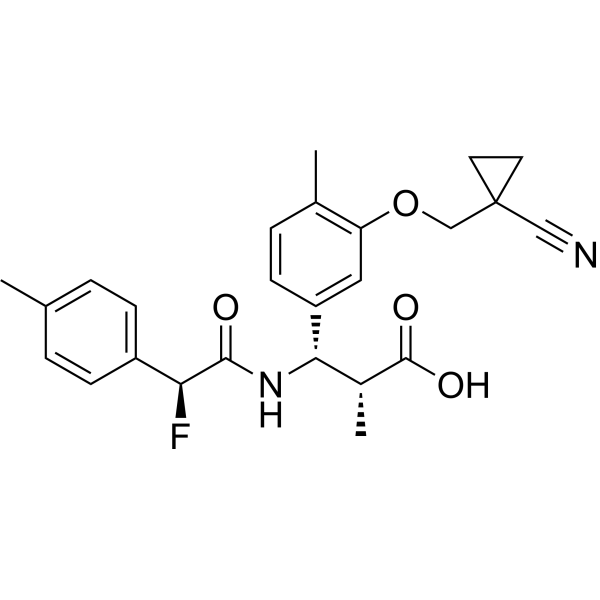
- HY-133887
-
|
|
Antifolate
DNA/RNA Synthesis
|
Cancer
|
|
Methotrexate α-tert-butyl ester, capped by OtBu, significantly reduces tumor growth in HT1080 tumor bearing mice. Methotrexate is an antimetabolite and antifolate agent and is also an immunosuppressant and antineoplastic agent .
|
-
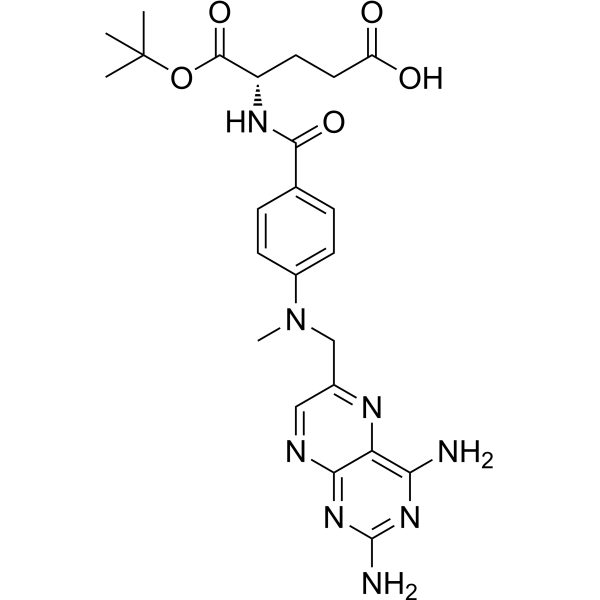
| Cat. No. |
Product Name |
Type |
-
- HY-156404
-
|
|
Dyes
|
|
PM-1, a derivative of Thioflavin-T (ThT; HY-D0218), is a small but highly specific plasma membrane (PM) fluorescent dye for specific and long-time membrane imaging of living and fixed cells. PM-1 is embedded directly into the cell membrane and exhibits a very long retention time on the plasma membrane with a half-life of approximately 15 h. PM-1 can be used in combination with protein labeling probes to study ectodomain shedding and endocytosis processes of cell surface proteins .
|
| Cat. No. |
Product Name |
Target |
Research Area |
-
- HY-N7122A
-
|
|
Endogenous Metabolite
|
Inflammation/Immunology
Cancer
|
|
Thymopentin acetate is a biologically active peptide secreted mainly by the epithelial cells of thymic cortex and medulla. Thymopentin acetate is an effective immunomodulatory agent with a short plasma half-life of 30 seconds. Thymopentin acetate enhances the generation of T-cell lineage derived from human embryonic stem cells (hESCs) .
|
-
- HY-P10019
-
|
NLY01
|
GCGR
|
Neurological Disease
|
|
Pegsebrenatide (NLY01) is a long-acting GLP-1R agonist. Pegsebrenatide has an extended half-life and favorable blood-brain barrier penetration. Pegsebrenatide can block A1 astrocyte transformation, reducing dopaminergic cell death, and improving motor symptoms in mouse models of PD .
|
-
- HY-P1838
-
|
|
Peptides
|
Cardiovascular Disease
|
|
Proadrenomedullin (45-92), human, a mid-regional fragment of proadrenomedullin (MR-proADM), comprises amino acids 45–92 of pre-proADM. Proadrenomedullin (45-92), human has a longer half-life, is relatively stable and is produced in equimolar amounts to adrenomedullin (ADM), making it a surrogate for plasma levels of ADM gene products .
|
-
- HY-P3347
-
|
|
Apelin Receptor (APJ)
|
Cardiovascular Disease
|
|
NH2-c[X-R-L-S-X]-K-G-P-(D-2Nal) (compound 40), a macrocyclic analogue of Ape13, is a potent APJ agonist (Ki=5.7 nM). NH2-c[X-R-L-S-X]-K-G-P-(D-2Nal) exhibits a favorable Gα12-biased signaling and an increased in vivo half-life .
|
| Cat. No. |
Product Name |
Target |
Research Area |
-
- HY-P99671
-
|
M-6495
|
ADAMTS
|
Inflammation/Immunology
|
|
Isecarosmab (M-6495) is an anti-ADAMTS monoclonal antibody (mAb) with a KD value of 3.65 pM. Isecarosmab has chondroprotective and anti-inflammatory activities. Isecarosmab can bind albumin to extend plasma half-life .
|
-
- HY-P99350
-
|
AMG 910; Anti-Human CD3xClaudin18 2
|
CD3
|
Cancer
|
|
Gresonitamab (AMG 910) is a half-life extended (HLE) bispecific T-cell engager (BiTE) antibody targets CD3-positive T cells and CLDN18.2-expressing tumor cells. Gresonitamab can be used for the research of adenocarcinoma .
|
-
- HY-P99756
-
|
MEDI8897
|
RSV
|
Infection
|
|
Nirsevimab (MEDI8897) is a recombinant human respiratory syncytial virus (RSV) monoclonal antibody with modified Fc region, which can prolong its half-life. Nirsevimab has an affinity for RSV-B with an Kd value of 1.5 nM. Nirsevimab can be used for RSV research .
|
-
- HY-P99930
-
|
|
FGFR
|
Metabolic Disease
|
|
Efruxifermin is an Fc-FGF21 fusion protein (human IgG1 Fc domain linked to a modified human FGF21). Efruxifermin has prolonged half-life and enhanced receptor affinity compared with native human FGF21. Efruxifermin can be used for the research of non-alcoholic steatohepatitis .
|
-
- HY-P99478
-
|
|
IFNAR
|
Inflammation/Immunology
|
|
Bifarcept is a recombinant antibody of interferon receptor type I (IFN-RI). Bifarcept can bind IFN-β and prolong its serum half-life .
|
-
- HY-P99562
-
|
XmAb-18087
|
CD3
|
Cancer
|
|
Tidutamab (XmAb-18087) is a humanized and affinity-optimized bispecific antibody (bsAb) targeting SSTR2 binding domain and T-cell binding domain (CD3). Tidutamab possesses a full Fc domain to maintain long serum half-life.Tidutamab eliminates SSTR+ tumor cells by stimulating redirected T cellmediated cytotoxicity (RTcC) .
|
-
- HY-P99814
-
|
AMG-701
|
CD3
|
Inflammation/Immunology
Cancer
|
|
Pavurutamab (AMG-701) is a bispecific T cell engager molecule that anti-CD3 and anti-B cell maturation antigens (BCMA). Pavurutamab has an extended half-life based on Pacanalotamab (HY-P99798). The Fc of Pavurutamab is coupled to molecules to improve pharmacokinetic parameters. Pavurutamab has potential applications in immune regulation and multiple myeloma (MM) .
|
-
- HY-P99340
-
|
VIR 7831
|
SARS-CoV
|
Infection
|
|
Sotrovimab (VIR 7831) is a human IgG1κ pan-sarbecovirus monoclonal antibody (mAb), neutralizes SARS-CoV-2, SARS-CoV-1, and multiple other sarbecoviruses. Sotrovimab is developed based on S309, exhibits a long half-life and great bioavailability in the respiratory mucosa. Sotrovimab could result in immune-mediated viral clearance and prevent progression of Covid-19 early in the course of disease .
|
| Cat. No. |
Product Name |
Category |
Target |
Chemical Structure |
| Cat. No. |
Product Name |
Chemical Structure |
-
- HY-B1118S
-
|
|
|
Secnidazole-d6 is the deuterium labeled Secnidazole. Secnidazole (RP-14539;PM-185184) is an orally active azole antibiotic with a longer half-life than metronidazole (HY-B0318). Secnidazole is against the vaginosis-associated bacteria and has the potential for bacterial vaginosis research[1].
|
-

-
- HY-B1118S1
-
|
|
|
Secnidazole- 13C2, 15N2 is the 13C2, 15N2 labeled Secnidazole. Secnidazole (RP-14539;PM-185184) is an orally active azole antibiotic with a longer half-life than metronidazole (HY-B0318). Secnidazole is against the vaginosis-associated bacteria and has the potential for bacterial vaginosis research.
|
-

-
- HY-121246S
-
|
|
|
Fluorofenidone-d3 is deuterium labeled Fluorofenidone. Fluorofenidone (AKF-PD), an analogue of AMR69, shows equivalent antifibrotic activity, lower toxicity and longer half-life. Fluorofenidone (AKF-PD) attenuates the progression of renal interstitial fibrosis partly by suppressing NADPH oxidase and extracellular matrix (ECM) deposition via the PI3K/Akt signalling pathway[1][2].
|
-

Your information is safe with us. * Required Fields.
Inquiry Information
- Product Name:
- Cat. No.:
- Quantity:
- MCE Japan Authorized Agent:






















































![NH2-c[X-R-L-S-X]-K-G-P-(D-2Nal)](http://file.medchemexpress.com/product_pic/hy-p3347.gif)









